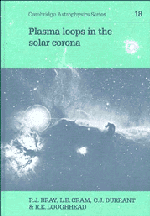Book contents
- Frontmatter
- Contents
- Preface
- Acknowledgements
- Other books by the authors
- List of abbreviations
- 1 Historical introduction
- 2 Cool loops: observed properties
- 3 Hot loops: observed properties
- 4 Flare loops: observed properties
- 5 Structure, dynamics and heating of loops
- 6 The plasma loop model of the coronae of the Sun and stars
- Additional notes
- Name index
- Subject index
4 - Flare loops: observed properties
Published online by Cambridge University Press: 22 October 2009
- Frontmatter
- Contents
- Preface
- Acknowledgements
- Other books by the authors
- List of abbreviations
- 1 Historical introduction
- 2 Cool loops: observed properties
- 3 Hot loops: observed properties
- 4 Flare loops: observed properties
- 5 Structure, dynamics and heating of loops
- 6 The plasma loop model of the coronae of the Sun and stars
- Additional notes
- Name index
- Subject index
Summary
Introduction
Solar flares are remarkably diverse and complicated phenomena involving the transient heating of localized regions of the corona and underlying chromosphere within an active region. The sudden release of energy is accompanied by the emission of electromagnetic radiation over a very wide span of the spectrum, ranging – in extreme cases – from γ-rays to kilometric radio waves. In almost all cases flares seen in the chromospheric Hα line also produce an increase in the flux of soft X-rays. Moreover, the variation in the soft X-ray flux with time roughly follows that of the Hα intensity at the brightest point of the flare (Svestka, 1981, p. 74). Both curves are characterized by a rapid rise to a comparatively short-lived maximum, followed by a much slower decay. The intensity of the soft Xray emission generally increases with the optical importance of the flare, although individual flares may show marked deviations from this rule. For this reason it has become customary to assign both an optical (Hα) and an X-ray importance to each flare. Both the Hα and soft X-ray emission pertain to what is conventionally called the ‘thermaly’ or ‘quasi-thermal’ component of the flare, i.e. they originate in plasmas where the distribution of electron velocities is believed to be Maxwellian.
Flares are classified optically according to their area at the time of maximum Hα brightness into the four categories listed in Table 4.1, adapted from Svestka (1981).
- Type
- Chapter
- Information
- Plasma Loops in the Solar Corona , pp. 166 - 260Publisher: Cambridge University PressPrint publication year: 1991



